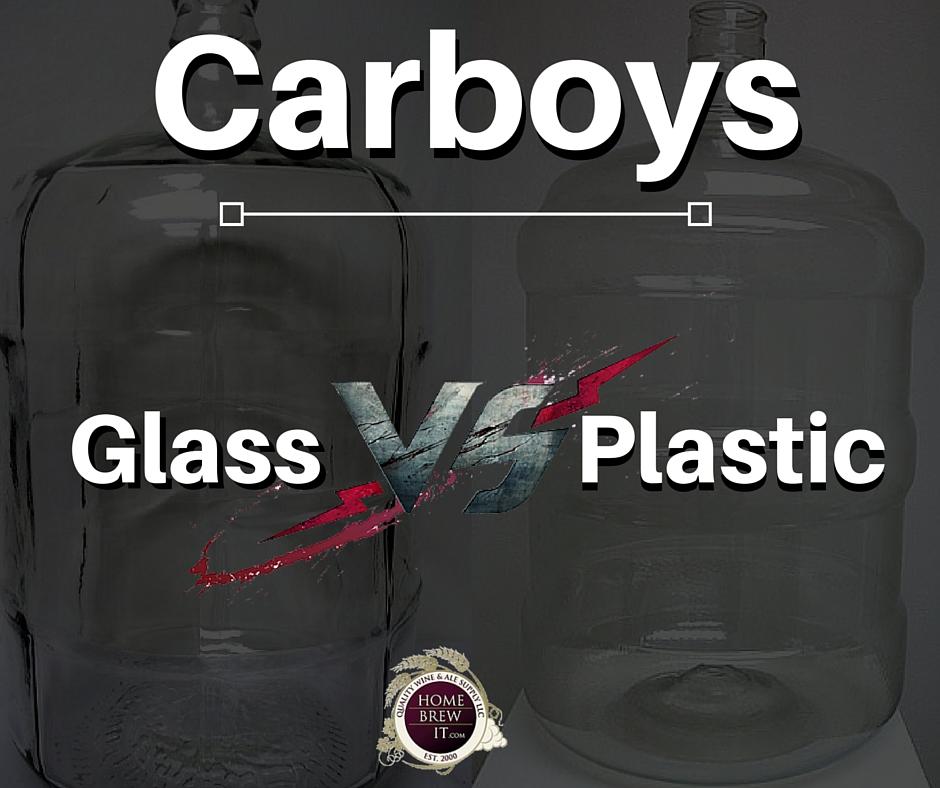
Comparing Glass and Plastic Carboys: Expert Advice

The Question I Hear at Least Once Per Day: Glass or Plastic?
For years, homebrewers and wine makers have fiercely debated on whether to use plastic or glass carboys during fermentation. Im going to warn you now: if you are looking for a definitive answer, you are going to be disappointed. There are pros and cons to both. I will lay them all out, and you, mighty homebrewer, will have to decide the best choice for yourself.Exhibit A: Oxygen Diffusion:
Beware: science ahead! Ever heard of Ficks Laws of Diffusion? Are you a chemist? If you answered no to both of these questions dont worry - youre in good company. I am also not a chemist, not a physicist, and not a scientist - even though some of my friends tend think I am upon tasting one of my homebrews (Id rather be known as a wizard, to be honest). So Ill make it simple. Adolf Fick postulated that molecules will undergo diffusion in order to create equilibrium.
Example: you decide to make yourself a hot cup of tea. You heat up the water in your kettle, place the tea bag in your cup, and pour the hot water on top. Sure, you get tea, but what happens to the cup?
The cup also heats up. In this example, heat is being diffused during heat conduction. Nature likes equilibrium. The heat from the water is diffused into the cup to create an equilibrium.
This happens on a molecular level during the fermentation process as well. Glass is, as far as we can tell, impermeable to air. So if you rack your wine or beer and leave it in a glass secondary for longer than you really should (were all guilty of this, right?), air will not be able to permeate the glass carboy and oxidize your beer or wine.
Plastic, on the other hand, is semi-permeable. Trace amounts of oxygen can diffuse through your plastic carboy and reach your fermenting wine or beer. Now, depending on the type of plastic, it can range from virtually no oxygen, to more oxygen than youd like - possibly even enough to oxidize your product. Most plastic carboys, especially the ones you will find in your local homebrew shop, are going to be food grade PET plastic (Polyethylene Terephthalate), or HDPE (High-Density Polyethylene) plastic. Both of these are nearly impermeable. You would have to leave your product in these for a long, long time before any oxygen reached it enough to oxidize it.
So Ill make it simple. Adolf Fick postulated that molecules will undergo diffusion in order to create equilibrium.
Example: you decide to make yourself a hot cup of tea. You heat up the water in your kettle, place the tea bag in your cup, and pour the hot water on top. Sure, you get tea, but what happens to the cup?
The cup also heats up. In this example, heat is being diffused during heat conduction. Nature likes equilibrium. The heat from the water is diffused into the cup to create an equilibrium.
This happens on a molecular level during the fermentation process as well. Glass is, as far as we can tell, impermeable to air. So if you rack your wine or beer and leave it in a glass secondary for longer than you really should (were all guilty of this, right?), air will not be able to permeate the glass carboy and oxidize your beer or wine.
Plastic, on the other hand, is semi-permeable. Trace amounts of oxygen can diffuse through your plastic carboy and reach your fermenting wine or beer. Now, depending on the type of plastic, it can range from virtually no oxygen, to more oxygen than youd like - possibly even enough to oxidize your product. Most plastic carboys, especially the ones you will find in your local homebrew shop, are going to be food grade PET plastic (Polyethylene Terephthalate), or HDPE (High-Density Polyethylene) plastic. Both of these are nearly impermeable. You would have to leave your product in these for a long, long time before any oxygen reached it enough to oxidize it.
Exhibit B: Is Plastic Food Safe?
 There is also the question of harmful chemicals. A lot of homebrewers and winemakers, especially the older folks, remember a time when using plastic to store food or drink deposited harmful chemicals into the thing being stored in it. This is no longer the case. If you purchase your vessel from a reputable homebrew shop, it is going to be made out of food grade, safe, plastic the same type of plastic used in restaurants and pubs all over the world. If you have questions about whether your plastic vessel is food safe, look at the number on the bottom. If you see a 1, 2, 4, or 5, its safe for use for food and drink.
There is also the question of harmful chemicals. A lot of homebrewers and winemakers, especially the older folks, remember a time when using plastic to store food or drink deposited harmful chemicals into the thing being stored in it. This is no longer the case. If you purchase your vessel from a reputable homebrew shop, it is going to be made out of food grade, safe, plastic the same type of plastic used in restaurants and pubs all over the world. If you have questions about whether your plastic vessel is food safe, look at the number on the bottom. If you see a 1, 2, 4, or 5, its safe for use for food and drink.
Exhibit C: How Strong Are You?
Im a 53, 130 pound female. Its safe to say that currently the only things I lift are my son and my daughter, and they weigh 40 and 20 pounds, respectively. I know there are some of you out there that could probably bench a Buick. Thats not me. Nope. Your standard glass carboy weighs just over 40 pounds. 6 gallons of fluid weighs about 9 pounds. Add trub, lees, fresh fruit, or whatever else you may be fermenting to that and you may be pushing 60 pounds. That may not seem like a big deal, but this is a large, awkward vessel, with fluid freely sloshing around. Lifting and carrying these things is not easy. Suffice it to say, if you drop it, its not going to be pretty. Broken glass, yeasty sediment, and ruined wine or beer EVERYWHERE. On top of that, they are much more expensive than plastic, and thus, harder to replace.
A plastic carboy weighs virtually nothing. So with fluid and other good stuff, were talking more like 20 pounds, tops. If dropped, they make a loud BONG sound, which is kind of funny. You feel stupid for a minute or so, and then move on with your life.
Your standard glass carboy weighs just over 40 pounds. 6 gallons of fluid weighs about 9 pounds. Add trub, lees, fresh fruit, or whatever else you may be fermenting to that and you may be pushing 60 pounds. That may not seem like a big deal, but this is a large, awkward vessel, with fluid freely sloshing around. Lifting and carrying these things is not easy. Suffice it to say, if you drop it, its not going to be pretty. Broken glass, yeasty sediment, and ruined wine or beer EVERYWHERE. On top of that, they are much more expensive than plastic, and thus, harder to replace.
A plastic carboy weighs virtually nothing. So with fluid and other good stuff, were talking more like 20 pounds, tops. If dropped, they make a loud BONG sound, which is kind of funny. You feel stupid for a minute or so, and then move on with your life.
Exhibit D: Price
I touched on this a bit in the last point, but Ill reiterate here: plastic carboys are much cheaper than glass. I dont think I need to expand on this. There are some folks that just need the cheaper option.Exhibit E: Aesthetic
Just as there are some folks that will always jump for the cheaper option, theres also the kind of folks that want something pretty. If you are fermenting right in the middle of your dining room, you may want to go with the glass option, simply because they are more pleasing to look at.Exhibit F: Cleaning
 Cleaning is already quite an ordeal with home brewing and winemaking, and a downside to plastic is that they tend to stain easier than glass. You may have noticed this with your racking assemblies and tubing. Over time, all plastic (because it is semi-permeable) will turn a nasty reddish brown color. They also scratch easily, so you are limited as to what brushes you can use to clean them. However, the necks of plastic carboys are wider, and its much easier to dump leftover yeast, trub, lees, and sediment.
Glass, on the other hand, will never stain and never scratch, but the necks tend to be smaller in width, making it more difficult to dump out unused product.
Cleaning is already quite an ordeal with home brewing and winemaking, and a downside to plastic is that they tend to stain easier than glass. You may have noticed this with your racking assemblies and tubing. Over time, all plastic (because it is semi-permeable) will turn a nasty reddish brown color. They also scratch easily, so you are limited as to what brushes you can use to clean them. However, the necks of plastic carboys are wider, and its much easier to dump leftover yeast, trub, lees, and sediment.
Glass, on the other hand, will never stain and never scratch, but the necks tend to be smaller in width, making it more difficult to dump out unused product.
In Conclusion:
I know you came here wanting answers. Im like that too. Give me a clear choice. Sorry, brothers and sisters in homebrewing, there is no clear answer here. Its a matter of preference. Both are widely used in homebrewing and home winemaking. Both will make a fantastic product. But, in case you need the cliffs notes, here are the main points:Glass Pros: Easier to clean, never scratch, prettier to look at, with no chance of oxygen permeation. Glass Cons: Bulky, heavy, hard to move. Easily broken. Smaller necks make it harder to transfer. Much more expensive and difficult to replace.
Plastic Pros: Easier to move, easier to lift, and easier to pour due to their wide necks. Science has also made them safe to store food and drink in. Easier on your wallet too. Plastic Cons: Harder to clean. Stains and scratches easily. Not as pretty to look at. Very, very, slight chance of oxygen permeation.
 Clear as mud? This is why if you call me and ask which to choose or which one is better, it may turn into a 20 minute long debate.
The choice is yours, and yours alone.
This is Heidi - HomeBrewIt Customer Service Rep. You can usually find me on our Instragram - @homebrewit. Give us a follow!
Good luck out there, fellow home brewers and wine makers! Cheers!
Clear as mud? This is why if you call me and ask which to choose or which one is better, it may turn into a 20 minute long debate.
The choice is yours, and yours alone.
This is Heidi - HomeBrewIt Customer Service Rep. You can usually find me on our Instragram - @homebrewit. Give us a follow!
Good luck out there, fellow home brewers and wine makers! Cheers!
